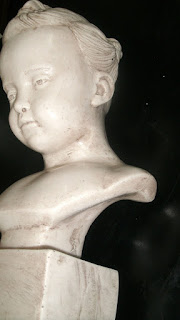"The Immaculate Conception."
Sculptor:- unknown.
Material:- Quartz crystal.
Size:- 58Cm high x 31cm
wide x 20 cm deep.
Wooden Base:- Bottom, 34cm x
20.5cm.
Top:- 29.5cm
x 19cm x 8cm deep.
Circa:- 1900 to 1910.
This “Immaculate
Conception” sculpture is unique in that it is made from beautiful
white Quartz Crystal from the Benguet area. It was obtained by a
collector in the late 1960's and has been in that collection until
now.
The sculpture was
purchased directly from the folk sculptors family members,
unfortunately all records of who the sculptor was have vanished with
time.
This sculpture was
purchased with the head broken and reattached to the sculpture, it is
not known but suspected that the damage occurred during the
sculptural process as Quartz Crystal, it is a very hard and brittle
crystal and difficult medium to work in.
This very beautiful
and unique work is carved out of one piece of Quartz Crystal.
Pure
quartz, traditionally called rock crystal or clear quartz, is
colorless and transparent
or translucent, and has often been used for hard
stone carving.
This is a masterly
sculpted work, the detail of the face, hands and clothing are very
well carved. There is a soft resonance within this work.
I do find this piece
quite alluring and there is an inner quality, a quiet serene presence
about this sculpture that is difficult to explain and yet you can
sense it when you come into its presence. One viewer wanted to touch
the sculpture as she felt a desire within herself to rub her hands on
the base as she felt she was being drawn into its healing presence.
This “ Immaculate
Conception” Sculpture is an experience to behold, this is no
ordinary sculpture.
This exceptional
piece is very unique and in all our research we have not at this
point in time found another Immaculate Conception carved in such a
large Quartz crystal.
Historical text
speaks about the nature of light and Quartz crystal, “Light (the
Son) striking the crystal (Mary) has long been the symbol of the
Immaculate Conception.”
The Immaculate Conception is commonly and mistakenly taken to mean the conception of Mary's son Jesus Christ in her own womb, and the virgin birth of Jesus. These are covered by the doctrine of the Incarnation, while the Immaculate Conception deals with the conception of Mary herself, not that of her son.
Power and Healing qualities of Natural Quartz Crystal
The clear quartz crystal is one of the most sacred stones of ancient cultures. Its clarity and transparency give it a mirror quality through which things can be seen clearly. The natural quartz crystal symbolizes white light energy.
The power of the crystal can be found in its structure - growing and reaching up toward light from the deepest parts of earth. It is a conductor of energy - both as a receiver and a transmitter. It is important to keep your crystal clean in order to protect it from outside negative vibrations. Your personal crystals will attune themselves to your vibrations, as you will attune to the natural vibrations of the crystal. Choose crystals that seem to speak to you or that you feel attracted to for best results.
Clear quartz crystals have been used for
centuries in healing.
Crystals have been used for healing the body,
transforming the spirit, inspiring intuitive insight, guarding
against negative vibrations, and smoothing the energy flows of spirit
and body.
Written by,
Mark Shellshear.
Art Consultant






















































